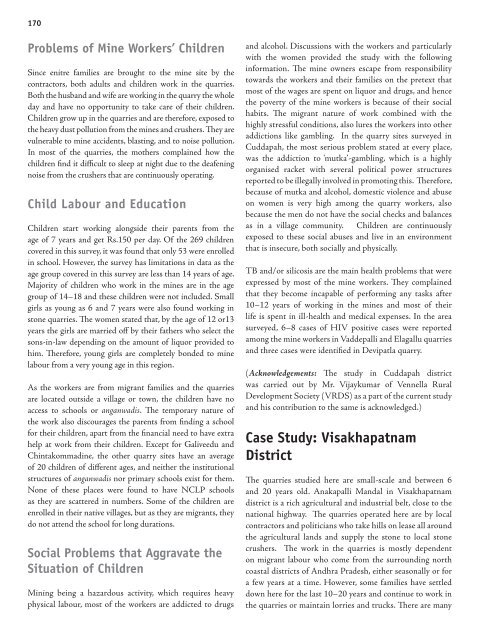Children - Terre des Hommes
Children - Terre des Hommes
Children - Terre des Hommes
You also want an ePaper? Increase the reach of your titles
YUMPU automatically turns print PDFs into web optimized ePapers that Google loves.
170<br />
Problems of Mine Workers’ <strong>Children</strong><br />
Since enitre families are brought to the mine site by the<br />
contractors, both adults and children work in the quarries.<br />
Both the husband and wife are working in the quarry the whole<br />
day and have no opportunity to take care of their children.<br />
<strong>Children</strong> grow up in the quarries and are therefore, exposed to<br />
the heavy dust pollution from the mines and crushers. They are<br />
vulnerable to mine accidents, blasting, and to noise pollution.<br />
In most of the quarries, the mothers complained how the<br />
children find it difficult to sleep at night due to the deafening<br />
noise from the crushers that are continuously operating.<br />
Child Labour and Education<br />
<strong>Children</strong> start working alongside their parents from the<br />
age of 7 years and get Rs.150 per day. Of the 269 children<br />
covered in this survey, it was found that only 53 were enrolled<br />
in school. However, the survey has limitations in data as the<br />
age group covered in this survey are less than 14 years of age.<br />
Majority of children who work in the mines are in the age<br />
group of 14–18 and these children were not included. Small<br />
girls as young as 6 and 7 years were also found working in<br />
stone quarries. The women stated that, by the age of 12 or13<br />
years the girls are married off by their fathers who select the<br />
sons-in-law depending on the amount of liquor provided to<br />
him. Therefore, young girls are completely bonded to mine<br />
labour from a very young age in this region.<br />
As the workers are from migrant families and the quarries<br />
are located outside a village or town, the children have no<br />
access to schools or anganwadis. The temporary nature of<br />
the work also discourages the parents from finding a school<br />
for their children, apart from the financial need to have extra<br />
help at work from their children. Except for Galiveedu and<br />
Chintakommadine, the other quarry sites have an average<br />
of 20 children of different ages, and neither the institutional<br />
structures of anganwadis nor primary schools exist for them.<br />
None of these places were found to have NCLP schools<br />
as they are scattered in numbers. Some of the children are<br />
enrolled in their native villages, but as they are migrants, they<br />
do not attend the school for long durations.<br />
Social Problems that Aggravate the<br />
Situation of <strong>Children</strong><br />
Mining being a hazardous activity, which requires heavy<br />
physical labour, most of the workers are addicted to drugs<br />
and alcohol. Discussions with the workers and particularly<br />
with the women provided the study with the following<br />
information. The mine owners escape from responsibility<br />
towards the workers and their families on the pretext that<br />
most of the wages are spent on liquor and drugs, and hence<br />
the poverty of the mine workers is because of their social<br />
habits. The migrant nature of work combined with the<br />
highly stressful conditions, also lures the workers into other<br />
addictions like gambling. In the quarry sites surveyed in<br />
Cuddapah, the most serious problem stated at every place,<br />
was the addiction to ‘mutka’-gambling, which is a highly<br />
organised racket with several political power structures<br />
reported to be illegally involved in promoting this. Therefore,<br />
because of mutka and alcohol, domestic violence and abuse<br />
on women is very high among the quarry workers, also<br />
because the men do not have the social checks and balances<br />
as in a village community. <strong>Children</strong> are continuously<br />
exposed to these social abuses and live in an environment<br />
that is insecure, both socially and physically.<br />
TB and/or silicosis are the main health problems that were<br />
expressed by most of the mine workers. They complained<br />
that they become incapable of performing any tasks after<br />
10–12 years of working in the mines and most of their<br />
life is spent in ill-health and medical expenses. In the area<br />
surveyed, 6–8 cases of HIV positive cases were reported<br />
among the mine workers in Vaddepalli and Elagallu quarries<br />
and three cases were identified in Devipatla quarry.<br />
(Acknowledgements: The study in Cuddapah district<br />
was carried out by Mr. Vijaykumar of Vennella Rural<br />
Development Society (VRDS) as a part of the current study<br />
and his contribution to the same is acknowledged.)<br />
Case Study: Visakhapatnam<br />
District<br />
The quarries studied here are small-scale and between 6<br />
and 20 years old. Anakapalli Mandal in Visakhapatnam<br />
district is a rich agricultural and industrial belt, close to the<br />
national highway. The quarries operated here are by local<br />
contractors and politicians who take hills on lease all around<br />
the agricultural lands and supply the stone to local stone<br />
crushers. The work in the quarries is mostly dependent<br />
on migrant labour who come from the surrounding north<br />
coastal districts of Andhra Pra<strong>des</strong>h, either seasonally or for<br />
a few years at a time. However, some families have settled<br />
down here for the last 10–20 years and continue to work in<br />
the quarries or maintain lorries and trucks. There are many






